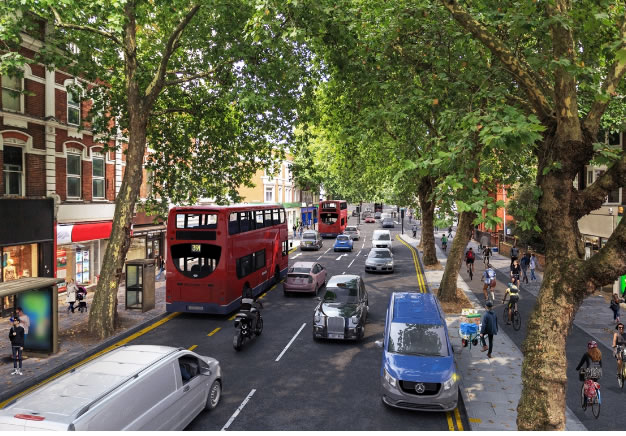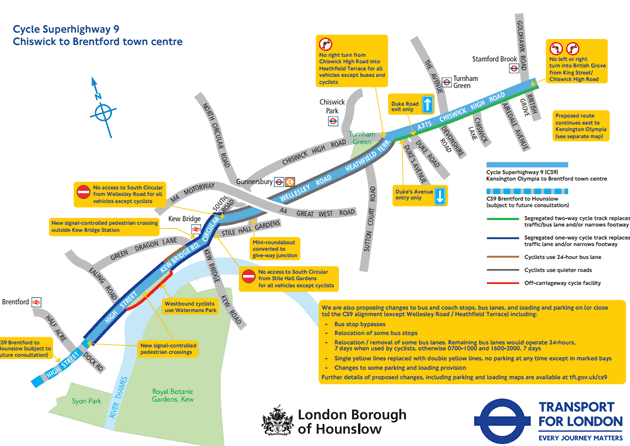Chiswick Councillors Unanimously Oppose Cycle Superhighway
Want TfL to withdraw scheme in favour of a radically different and cheaper plan

A damning criticism of the proposed Cycle Superhighway through Chiswick has been made by local councillors who say it will not improve air pollution, will affect local businesses, and does not strike a balance between the needs of cyclists and other stakeholders.
They have called for the the scheme to be withdrawn until TfL enter "serious
discussions" with representatives of local stakeholders and residents
and then bring forward a radically
different and preferably less expensive proposal.
The nine Chiswick councillors representing the three local authority wards have outlined their criticisms in their formal response to TfL's consultation on the extension of CS9.
They say they are unanimously opposed to the CS9 in its current form and it could blight large parts of the High Road. It will only be of minimal benefit to cyclists and will have a detrimental effect on the quality of life for pedestrians. They also criticise TfL for not presenting an alternative option or routes for the cycle highway.
The councillors say they reached their conclusion unanimously after reading
the consultation documents, consulting widely with residents and after
having sought and received clarification from TfL on a number of issues.
The following is the full text of their response:
"We have not reached this decision lightly. We fully support, in
principle, the implementation of schemes that will make our streets safer
for cyclists and that will encourage residents and
commuters to “get on their bikes”. However a proper balance has to be
struck between the legitimate needs and aspirations of cyclists and those
of the many other local stakeholders.
We do not believe that the proposed scheme strikes such a balance nor
that it can be easily
modified in order to do so. We list below some of the reasons why we oppose
the scheme and would welcome the opportunity to discuss these further
with representatives of TfL.
1. The adverse impact on air pollution on this already heavily polluted
road: Chiswick
High Road has one of the worst records for air pollution in London and,
as TfL’s own
modelling demonstrates this scheme will do nothing to improve it. The
scheme is forecast
to reduce average vehicle speeds. This will increase the air pollution
from stationary and
slow moving traffic. No traffic scheme by TfL, let alone one costing £70m,
should proceed
if it actually makes air pollution worse.
In addition, the scheme is dependent upon the closure of the western
exits from Stilehall
Gardens and Wellesley Road. This will force residents in that part of
Chiswick and others
who use these roads to divert on to the High Road. This will increase
and not decrease
the air pollution on Chiswick High Road. No decision has been made by
Hounslow
Council on whether or not to close the western exits from these two roads.
The results of
the public consultation held on the proposed street closures were inconclusive
and were
hardly the basis for making such a fundamental and potentially damaging
change.
2. The damage to businesses on both the north and south side of the High
Road. It is
clear that owners and representatives of local businesses operating from
both the High
Road and the neighbouring streets do not support the scheme. This gives
the lie to TfL’s
own unsupported assertion that the cycle route will bring additional trade
into the heart of
the town.
We are baffled as to why TfL’s appears not to have carried out any research
with local
businesses before they drew up such a detailed scheme for public consultation.
Even
during this consultation many businesses have complained to us that they
have not been
contacted individually by TfL representatives as promised.
There are other specific issues that have both angered and frustrated
local business
owners. For example, the construction of the segregated Cycle Way will
significantly eat
into the pavement space that is such a vital part of the shopping experience
of Chiswick
High Road. The need for additional signage and bike racks will also further
encroach on
the pavement space.
On the south side of the High Road a number of businesses are extremely
concerned
about the proposed introduction of double yellow lines on the road and
the way in which a
segregated cycle way will block access for delivery vehicles. This could
actually destroy
businesses and blight large parts of the High Road. This point has not
been addressed by
TfL in the consultation so far as we are aware.
3. The quality of life for pedestrians will be significantly impaired:
See above for the
loss of pavement space, the addition of more street furniture and the
increase in air
pollution. It is also apparent that the construction of a two way segregated
cycle way will
make life more difficult for pedestrians particularly the elderly and
those with impaired
vision and those with restricted mobility. Put simply pedestrians (including
dismounted
cyclists) attempting to cross the High Road will have to negotiate both
a busy road and
the two-way Cycle Superhighway. Specific concerns have also been raised
by groups
such as the Catholic Church for whom the existing wide pavement is essential.
TfL have
offered to police cyclist behaviour but the numbers of Enforcement Officers
offered could
not be an effective deterrent.

Click here for larger version of this map
Further
details with maps and images available on the TfL website.
4. The plight of bus passengers, motor cyclists and delivery drivers and
those for
whom cars are essential is totally ignored by the scheme. TfL acknowledges
that the
introduction of the scheme will slow average journey times. Can the improved
experience
for cyclists really be justified by the damage done to the lives of other
stakeholders? To
quote just a couple of examples; safety cage road markings at junctions
that protect both
motor cyclists and cyclist will be lost if CS9 is implemented. In addition
not only will bus
passengers have their journey times extended but since buses are amongst
the biggest
polluters of the air, pollution will increase if their average speeds
are reduced.
5. The benefits to cyclists will be minimal and most of these could be
achieved
through "softer" cheaper measures not involving a dedicated
two way cycle
superhighway. It is a striking feature of the so called consultation that
no options or
alternatives are proposed. In our opinion the obsession with delivering
a "big project" has
blinded TfL to the fact that driving along the High Road will become slower
and more
unpleasant for the vast majority of residents and for those transiting
through the
area. Between Hammersmith and Chiswick Roundabout there are at least fourteen
junctions at which cyclists will have to stop to allow pedestrians and
other road users to
cross. Is this the Super Highway cycling experience that TfL is trying
to promote?
Those councillors that cycle regularly have pointed out that there are
a number of
relatively inexpensive road improvements that TfL could make that would
significantly
improve the safety of cyclists e.g. the removal of ‘pinch points’ at pedestrian
crossings.
This would make the existing cycle routes more attractive and better used.
6. There is no evidence that TfL has seriously considered the obvious
and on the face
of it far cheaper alternative route along the A4. As mentioned above we
believe that
the absence of any alternative options or routes in the consultation documents
is highly
significant. Our enquiries of TfL as to why the A4 route was not considered
have
produced only superficial responses. Given TfL’s huge experience in commissioning
and
building transport infrastructure it is not acceptable for us to simply
be told that providing
a new cycle way across the A4 would be technically difficult and expensive.
This is a
£70m project. How difficult would it be to engineer a new crossing
for cyclists on the A4 if
this was the best option?
7. The cycle route does not go to Chiswick Business Park, an important
area of
employment on the High Road. Most councillors thought that this was simply
another
indication of the flawed nature of the scheme’s design and the failure
of TfL to really
understand the dynamics of Chiswick’s micro-economic landscape. TfL has
cited the
technical problems of bringing the scheme across Chiswick Roundabout.
However, the
failure to incorporate the Business Park into the scheme seems eccentric
to say the least.
8. Chiswick residents have been told by TfL to think of "the bigger
picture". We would
in turn ask TfL to ask itself why Chiswick residents should support a
scheme that would
so radically alter their town centre and yet provide so few tangible benefits
to anyone
living in the area other than a relatively small number of cyclists.
Conclusion
There are streets on which the introduction of a Cycle Super Highway
can be hugely
beneficial, it is however abundantly clear that Chiswick High Road is
not one of them.
If TfL is determined to spend £70m of public money on improving
Chiswick’s transport
infrastructure then they must demonstrate that it will spend these funds
wisely. We believe
that there are a number of more cost effective ways of achieving the same
or similar
objectives. It is unfortunate that the scheme being consulted on will
do nothing to improve the
areas already poor air quality and that it will damage rather than benefit
many of the existing
businesses on Chiswick High Road.
TfL should formally withdraw the proposed scheme and enter serious discussions
with
representatives of local stakeholders and residents and then bring forward
a radically
different and preferably less expensive proposal. The Conservative Councillors
stand ready
to assist this process in any way
The CS9 is part of the Mayor's draft Transport Strategy and Healthy Streets project which aims to encourage walking, cycling and using public transport. TfL say it will provide improvement for all road users and offer a clearer and safer route for people to cycle in West London, make it easier to cross busy roads, and remove traffic on some residential roads.
November 18, 2017